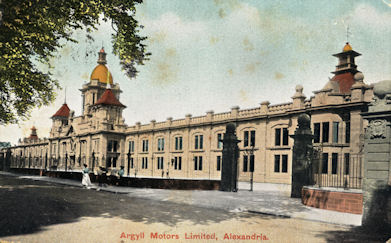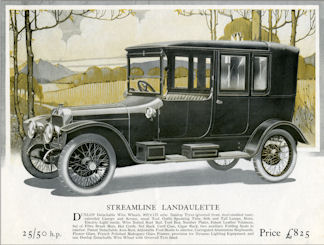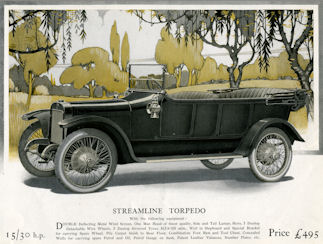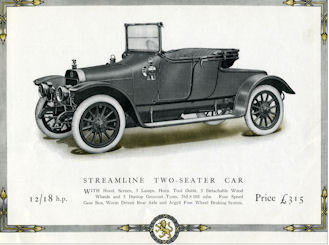Industry in the Vale of Leven - Page 4
Page 1 | Page 2 | Page 3 | Page 5
The 1930's Depression was an extremely challenging time for the Vale and for the UTR. The UTR survived by focusing on costs. Sometimes it took cost cutting too far - as in 1931 when, in common with other Scottish textile companies, it imposed an additional wage cut on top of a nationally agreed one. This brought another major strike down on its head, with 5,000 people marching on Dalquhurn and violent disturbances. Eventually the UTR won, but wages were not the major problem, lack of demand for their products was. Cordale and Levenbank were on very shaky pegs throughout the 1930's, and it was no surprise that the end of WW2 found them closed, with most of Dalquhurn following suit shortly thereafter when it was sold to another English organisation.
As we already noted, by this time the top management was completely remote from the Works. The head office was in Glasgow, and it's questionable how much feel for the business the directors had by this time. The executive managers were, however, still trying to fashion a sustainable business out of the UTR, and various attempts at modernisation were made at the Craft and at the part of Dalquhurn in which the UTR was still operating. It's impossible not to feel considerable sympathy with these efforts. Just about everything that could be tried - from new products to new processes - was tried. Its easy now to say that it lacked focus, that it has the whiff of panic about it. But if they hadn't tried everything they'd be criticised for not trying hard enough.
No one else in British bleaching, dyeing and printing found the solution either. CPA being bigger, and having a bit more money than the UTR, just took longer to reach the same point. This was after they took over the UTR in 1960, and closed it down immediately. This was of course a desperately unhappy ending for the UTR and the Vale. One assumes that it was also so for the chairman - H Cowan-Douglas, whoever he was - from his view of events from his office in 46 West George Street Glasgow. For about the last 35 years of the UTR's existence, this is where the board had insulated themselves from the Vale works and the people who worked there. Absentee directors in every sense, not only did they not work in the Vale, they didn't live there either.
What became of the CPA? It soldiered on, but not much longer. Not long after it closed down the UTR, it was taken over by Tootal, of Tootal Ties fame, which was also based in Manchester. The CPA name soon disappeared from the business world, although some of its old offices in Manchester still carry the CPA emblems. Tootal merged with Coats Viyella in 1989. About 10 years later, Coats Viyella de-merged, and the separate parts are now part of other organisations. Like most of their former factories, little visible evidence remains of corporate UTR, although Glasgow University owns 10 shelf-feet of the UTR archive, including a partial list of employees.
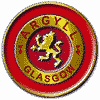 In the early 1900's, just as the potential problems in the bleaching and dyeing industry were becoming apparent to all, manufacturing diversification appeared to be at hand. The story of Argyll Motors Ltd doesn't start in Alexandria, but it has certainly played a highly visible part of the life in the Vale for the past 100 years. The story begins in Hozier Street in Bridgeton, Glasgow, when Alexander Govan, who up until then made bicycles, decided to join the increasing boom in the use of the motorcar, by making Renault cars.
In the early 1900's, just as the potential problems in the bleaching and dyeing industry were becoming apparent to all, manufacturing diversification appeared to be at hand. The story of Argyll Motors Ltd doesn't start in Alexandria, but it has certainly played a highly visible part of the life in the Vale for the past 100 years. The story begins in Hozier Street in Bridgeton, Glasgow, when Alexander Govan, who up until then made bicycles, decided to join the increasing boom in the use of the motorcar, by making Renault cars.
In 1899 Govan formed Hozier Engineering, with a £15,000 investment from the National Telephone Company, and started to make cars on his own behalf, the Argylls. He was successful and Hozier was building about 10 cars a week by 1904, one of which drove from Land's End to John O'Groats in 1904 in 42 hours - a considerable achievement for those early days of automobiles and road surfaces which truth to tell probably weren't much worse than many in the area now.
Govan was an ambitious entrepreneur and he soon began to aspire to volume production of his cars. He already understood that he could steal a march on his competitors by using the latest manufacturing and engineering techniques in a volume-production factory. He also understood that the best way to achieve his manufacturing goals was in a new purpose-built factory with plenty of space to build and expand the production lines he had in mind. For this he needed a green-field site. Having searched around he decided on a site in north Alexandria in 1905.
He then did what a similar businessman would do to day - he formed a new company to deliver his vision and issued shares in the company to raise the necessary capital. Argyll Motors Ltd was incorporated in 1905, £500,000 in share capital was raised from the financial markets and building work began on the green-field site in Alexandria in April 1905.
The factory was officially opened in June 1906 - just 14 months later - but production had actually started some months previously. Getting such an 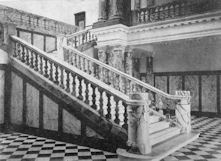 innovative, and, for its time complex,
factory up and running in such a short timewas a remarkable achievement. If the spend on the building raised a feweyebrows - the marble staircase and gold leaf on the dome, to mention but two of the apparent extravagances which have endured for 100 years in Vale folk-lore, the factory's approach to manufacturing and production engineering processes still look impressive to-day. On top of that, the staff facilities in terms of dedicated training areas, dining rooms, health and safety etc are just about as good as you'll
find in factories being built to day.(Click Image to Enlarge)
innovative, and, for its time complex,
factory up and running in such a short timewas a remarkable achievement. If the spend on the building raised a feweyebrows - the marble staircase and gold leaf on the dome, to mention but two of the apparent extravagances which have endured for 100 years in Vale folk-lore, the factory's approach to manufacturing and production engineering processes still look impressive to-day. On top of that, the staff facilities in terms of dedicated training areas, dining rooms, health and safety etc are just about as good as you'll
find in factories being built to day.(Click Image to Enlarge)
In communications as in many other ways it was leading edge for its day -
every main room had telephones, which could make external calls. The £250,000 it cost to build was certainly a big sum for the day, it was also half of the available share capital, but it was not of itself a fundamental threat to the financial well being of the company. Indeed Argyll Motors initially prospered - it made 60 cars a week, for a time employed 2,000 men and paid dividends at the rate of 10% for the first 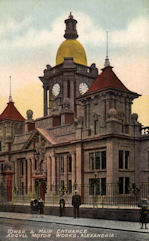 two and a half years. However, in May 1907 Mr Govan suddenly died of a cerebral haemorrhage and the company lost its driving force.
two and a half years. However, in May 1907 Mr Govan suddenly died of a cerebral haemorrhage and the company lost its driving force.
Just over a year later in July 1908, Argyll Motors had its first financial crisis. It went into liquidation and was financially and operationally restructured. This seemed to do the trick and although the work force was reduced to about 1,300 the company seemed to prosper. Typical Argyll cars included:
- The Torpedo Car a 15 HP car - the Flying Fifteen - of 1910, which cost £445
- The Double Phaeton a 12 HP model of 1912, which cost £335
- The Prince Henry Single-Sleeve Valve Car a 25 HP model costing £690
- Limousine-Laundaulette, again 25 HP model costing £800.
(Click Images to Enlarge)
An Argyll car broke the world speed record in 1913, an event recognised by a civic reception back in Alexandria. The Argylls were seriously expensive cars for their day, but it has to be remembered it was only the well off who were buying cars anywhere in Europe at this time. There were certainly more than enough of them to buy the 3,000 cars a year which Argyll aimed to make and sell. In fact, the Alexandria factory was for a time, producing more cars than any other car factory in Europe. The mass market opened up by Henry Ford's Model T hadn't yet arrived, but because of Govan's plans and foresight, the factory he built would certainly have been ideally placed to compete in volume production to supply a mass market.
But it was not to be. In June 1914 Argyll Motors once more went into liquidation, and the Alexandria works were closed. Argyll Motors went back to the Hozier works at Bridgeton, (which had never in fact been relinquished, and which might well have contributed to their financial problems), and continued in very low volume production until 1928. For Alexandria, Argyll Motors remains the great “what if?” of its history. What if Govan hadn't died? What if Argyll Motors had staggered on for a few more weeks until the outbreak of the First World War? What if some other vehicle manufacturer had moved in rather than a munitions manufacturer who was only ever likely to be there for the duration of the War?
Still, Argyll Works provided employment for 1,500 people - 600 of whom commuted into the Vale by train from Glasgow every day, which was a completely new concept. It generated a considerable amount of cash in and around Alexandria for a number of years. It provided new skills for many Vale folk, which they could apply elsewhere, at least until the Depression of the 1930's set in.
One of the people it trained was John Logie Baird the inventor of television, who worked as an engineering apprentice for Argyll, as did the man whose face was the first to be transmitted on television in 1926, Oliver Hutchison. They were apprentices in Argyll at the same time and later worked together on the development of television. And it provided the Vale with a visually pleasing building which still looks as good 100 years on as it did the day it opened, and better than just about anything that's been built anywhere in Scotland in that time.
Early in 1915, it was clear that the War was going to be long slog, and that it was going to require considerable industrial support from all sectors, particularly the munitions industry. The arms manufacturers had to find spare manufacturing capacity, and a supply of workers very quickly. The Argyll Works was lying empty, and Armstrong Whitworth, one of the leading arms companies of the day moved in. They also took over the adjacent land, which now houses the Swimming Pool and the Argyll Park. In it they built a complex of semi-underground bunkers in which Lyddite explosives were manufactured and underground pits in which small tests could be made.
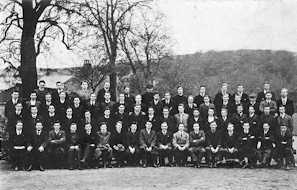
Armstrong Whitworth Apprentices from 1915 - 1919 (Click to Enlarge)
Throughout the war, about 2,000 local people and about 500 Belgian refugees were employed between the Argyll Works and “the Lyddite”, as it became known. The munitions work took up the slack in the labour market, which by now was evident in both the UTR works and Dalmonach. (Ferryfield completely closed in 1915, but had already been running down before that). However, in 1919 the Argyll Works and the Lyddite were both closed down. The Belgian refugees started to go back home, but about 2,000 Vale people were out on the street with no jobs to go to, and the depression had already started in the Vale 10 years before it hit the rest of the industrial world.
While the War was on, another supplier to the armed forces came to the Vale, but on a much smaller scale. In 1915 The Loch Lomond Radium Works was opened at Balloch, attracted, like the textile industry before it, by the plentiful supply of clean water. Radium was an element, which had been discovered recently by the Curies in France during their pioneering work on radioactivity. Its applications were still of an innovative nature although some, such as its use in X-rays and its ability to kill diseased tissue were well enough understood by 1915. It therefore was in demand by doctors caring for the wounded from the fighting.
The full implications of its harmful effects on health were not, at this stage, fully understood by anyone. The Radium works were set up John Stewart MacArthur who had a long and distinguished career as a chemist. The works produced radium salts for use by the Admiralty in luminous materials, and also for use in medicines. It was a small operation, employing probably no more than 20-30 people, and the main public interest seems to have been whether or not Madame Curie would visit the site. (By 1915 she was at the height of her international fame, twice a Nobel prize-winner, the first woman to be so, and still the only person to win the Nobel prize in two different scientific fields). Did she visit? Almost certainly not, but it's another good urban myth.
There is now no visible trace of the Works. They were in operation for only 5 years, closing in 1920, on MacArthur's death, which may well be a blessing given all that we now know about the health hazards of radium. The building stood on the east bank of the River Leven at Balloch, no more than a few feet from the water's edge, about 30 yards from the embankment of Lomond Road just before it crosses the new bridge. The old Waterlot function suite stood on part of the works. However, the building outlasted the works by about 40 years, and was only knocked down in the late 1950's or early 1960's.
For a number of years until the mid 1950's the building was used as a piggery. It was owned by Duncan (Dunky) Davidson who lived nearby at the top of the lane by which you accessed the Radium works from Dalvait Road. For all of the time that it was a piggery, no one thought of the potential health hazard it constituted. When Duncan Davidson gave up pigs, it was because government subsidies were shifted to favour the bigger producers, and his pigs became unprofitable, not because anyone saw any dangers in allowing potentially radioactive pigs into the food chain. When he got rid of the pigs, Dunky switched to donkeys, and many people will remember his donkey rides in Moss of Balloch Park. It is safe to say that Dunky's health was never known to have been affected by his exposure to radioactivity, and he happily lived to a ripe old age, on whisky, cigarettes, and laughter - and the attentions of his wife.
By 1922, Alexandria Labour Exchange, which was then at the corner of Bank Street and John Street, had 3,000 people registered as unemployed. Not surprisingly, it was the busiest Labour Exchange in Scotland. The only possible new employer in the Vale for most of the 1920's was a company called Scottish Amalgamated Silks, who came to the Argyll Works in 1926. Their stay was short-lived and they disappeared completely by 1929 - into Duke Street jail for fraud, in the case of one of their directors - without leaving any evidence of having done anything at Argyll Works.
In 1929, another new company arrived, this time at Balloch, French-owned in spite of its name - the British Silk Dyeing Company. It opened what became known to one and all as “the Silk Factory”. The venture failed within a few months, and the factory lay closed for a couple of years. It was then taken over by the Swiss firm Farberei Schuster-Insl of Zurich. The operation, which the Swiss were going to run at Balloch, was a complex and sophisticated one for its day. The Swiss therefore sent over a management and technical team to run their new factory.
Many of the Swiss were here for the 30 years or so that the Swiss owned the firm. Some retired and died here, while there are still some descendants of the original Swiss managers living in the area. However, what became a mutually beneficial and very happy relationship, did not start that way. Within two years of the re-opening under Swiss management in 1932, the BSD had a strike on its hands in 1934. The issues were pay and union recognition. After a pretty nasty confrontation, including the jailing of protestors, the matter was settled by a pay increase and union recognition. However, that was the last industrial relations problem that the Works were to have.
The Swiss turned out to be very good managers. The first Swiss Managing Director was Ernst Hofstetter, who also became the Swiss Consul in Scotland. It was easy to tell his house on the Luss Road out of Balloch by the large flagpole flying the Swiss flag. At its peak, the BSD employed about 500 people at Balloch. Even at the beginning of 1980 there were 300 employees, and when it eventually closed later in 1980, about 220. The Swiss owners had sold the BSD to an American company, United Merchants and Manufacturers Ltd in 1960. The Americans ran it very successfully under the direction, firstly, of Tom Carter and then Floyd Lee Parker, and finally Frederick Jackson, until the pressures of cheap far east textiles made the operation unprofitable.
The BSD's fate was sealed after a bizarre accident caused the boilers to explode one night. The total costs of repair could not be justified. It was announced in April 1980 to a surprised workforce and Vale community that the factory would close with virtually immediate effect. Most of the employees found other work quite quickly in places like Polaroid and the Clyde Naval Bases. Some of the Silk Factory employees even went to work for United Merchants in the US. And that was the end of the textile industry in the Vale. 1715 - 1980, a good run you might say, 265 years, and nothing lasts forever.
An excellent book has recently been written about the BSD, by two people who used to work there, and therefore know it best - “Behind the Silken Veil” by Ian Bisland and Malcolm Lobban (2004).
The silk factory site was a substantial piece of ground, much sought after by property agents and builders, and their various baggage trains. However, a part of it occupied one of the finest views in the world, never mind Scotland. An outstanding opportunity to create a signature development on a unique site, worthy of its surroundings. What's on the site? Houses and Lomond Shores.
By the early 1930's the employment situation in the Vale was desperate. Although the 5 remaining UTR factories were open, two of them - Cordale and Dillichip - were doing practically nothing, while the other three were running at very much reduced capacity and employment. The remaining CPA factory, Dalmonach, closed in 1929. Also, the yards and factories on the Clyde that had been the Vale's employment safety-valve in the 1920's, were themselves shut or in dire straights.
The Vale and parts of Wales had, for a time, the unenviable distinction of being the worst employment black spots in the whole of the UK. From 1930–33 almost 60% of the total work force was unemployed. Such was the demand for its services (it was where the unemployed queued to be paid the dole) that a new Labour Exchange had to be built in Alexandria - probably the only expanding business in the Vale at time - in Leven Street. It was opened in 1936, but closed in the 1980's when the Job Centre was opened. It has been converted to apartments. It is a listed building, because it is one of very few in the UK to carry the designation “EVIIIR”, in recognition of King Edward VIII who abdicated shortly after the new Labour Exchange opened.
The Admiralty re-opened the Argyll Works in 1935 to make torpedoes, renaming the works the Royal Naval Torpedo Factory (RNTF) or, as the Vale people called it, “the Torpedo Factory”. The work force was fairly quickly ramped up to about 750, and expanded even further after war broke out in 1939, especially as it started to work on a 3 shift, 7 days a week basis. The torpedo factory continued in production until the late 1960's.
In the mid-1950's the torpedo factory at Greenock closed down and its work was transferred to Alexandria. While many of the Greenock workers commuted by specially laid on buses (via the Erskine Ferry), many came with their families to live in the Vale. This was the latest wave of “immigration” to the Vale, and easily the shortest distance 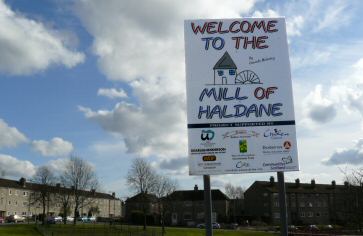 travelled. Most of the people from Greenock and Gourock moved into new houses in the Haldane, as the first occupants of these houses, about 1954-55.
travelled. Most of the people from Greenock and Gourock moved into new houses in the Haldane, as the first occupants of these houses, about 1954-55.
The person in charge of the Torpedo Factory was a naval officer, and it was very much a naval establishment, albeit an industrial one. In the1950's and 60's it was working on the latest, wire-guided torpedo, and the Russians actively sought information about that torpedo. A couple of spy rings were unmasked at the RN Development Base at Portland and in London - the Krogers and the admiralty clerk, as he was described, Vassal, went to jail for many years for spying on work, part of which was carried out at Alexandria.
Ironically, the torpedo never really worked properly (but even that information would have been helpful to the Russians) and that was no doubt one of the reasons why the Labour government decided to place future torpedo programs with Plessey, and close the RNTF in the late 1960's.
This did not have an immediate impact on employment, because Faslane Naval Base had already opened by this time, and Coulport was shortly to follow. There were jobs for all of the RNTF workers who wanted to go to work in these bases. Most would probably have chosen to transfer anyway, but the government eased the way with private coaches, paid travel time, etc, and a big majority chose to go.
Plessey, who had won the electronic torpedo work, took over the Torpedo factory to carry out other commercial electronics work. Although it was never specifically said so, this was probably part of the torpedo deal, as was the fact that they could leave Alexandria as soon as decently, or even indecently, possible. Also, the government changed in 1970 when the Conservatives unexpectedly beat Labour, and they may well have felt no loyalty to any private or secret deal.
Perhaps we do everyone concerned an injustice, but in any event Plessey announced in 1971 that they were going to close the Torpedo Factory. A work-in ensued for a number of weeks, but the outcome was inevitable and Plessey duly departed in 1972. The factory was duly designated Alexandria Industrial Estate, which suggests that from the outset no one expected a major single occupant. That was realistic.
A contemporary account of the Plessey closure >
A few, small, manufacturing units operated there from time to time, including Wellowear who made children's clothes, and Robin Campbell, who took over the building beside the railway line and indeed still operates a heavy vehicles refurbishment plant there. Apart from that operation, all manufacturing left the site in the early 1990's when it was divided into two separate areas. The imposing front offices were converted into an outlets shopping mall, with some big names such as Armani having shops there. It was very successful for a time, but time will tell if having Lomond Shores only a mile away is a challenge too far. The other part of the site, where manufacturing was carried out, is now houses.
During the 1930's, the government realised the need for diversification in hard-hit areas such as the Vale. The plans, which they formulated, were based on new industrial estates, aimed in particular at light engineering. As war approached, the concept was introduced of “Shadow” factories, factories that would be built to “shadow” existing war-effort factories, which were rightly expected to be early targets of enemy bombing.
The Rolls Royce engine plants were an early example of this, and the Rolls Royce plant which was at Hillington (now Inchinnan) was an early shadow factory. Industrial and economic planners quickly saw that the principles behind shadow factories lent themselves almost completely to the new industrial estates which were planned. These principles called for cheap, but well equipped buildings - low-rise rather than 4-5 storeys - in places with a plentiful supply of labour, not in built-up surroundings, and shared common services such as canteens.
There were actually a small number of off-the-shelf plans for the new factories available from the late 1930's onwards. The shadow factories proved a success beyond people's expectations. It was very easy to set up operations in them, they were flexible to operate, they were cheap to build and run, people liked to work in them. The concept of the industrial estate worked, and at the end of the war, plans were ready to be executed on the chosen sites.
Page 1 | Page 2 | Page 3 | Page 5

